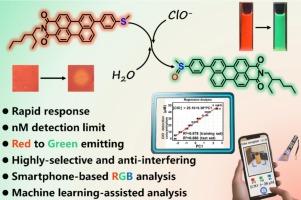基于苝酰亚胺的红色荧光探针用于快速和选择性次氯酸盐监测和机器学习辅助传感分析
IF 4.9
2区 化学
Q1 CHEMISTRY, ANALYTICAL
引用次数: 0
摘要
次氯酸盐(ClO−)是一种高度活性氧(ROS),在抵抗微生物攻击中起着至关重要的作用。此外,氯离子在日常生活中被广泛用作漂白剂和消毒剂。然而,它的过度使用可能导致水生动物死亡和人类呼吸。因此,开发一种用于环境和病理的快速ClO -检测工具至关重要。在本文中,我们报道了一种荧光探针(PMIS)的合成,该探针是由苝单亚胺(PMI)核心与硫醚部分整合而成的。基于分子内电荷转移(ICT)机制,PMI-S经过硫醚氧化过程,特异性识别ClO−,具有高选择性、快速响应(15 s)和38.8 nM的低检测限(DL)。在ClO−的作用下,PMI-S的荧光从613 nm向499 nm发生蓝移。此外,通过高分辨率质谱法、1H NMR滴定法和DFT理论计算系统地阐明了识别过程。利用其卓越的传感性能,PMI-S证明了对水生环境中ClO -污染物的高精度量化,回收率达到95.5 - 103.5%。此外,我们设计了一个三平台检测系统,包括(i) pmi -s功能化的纸张传感器,(ii)智能手机辅助色度分析平台,用于即时现场ClO -监测,以及(iii)机器学习辅助传感分析方法。本文章由计算机程序翻译,如有差异,请以英文原文为准。

Perylene monoimide-based red-emitting ratiometric fluorescent probe for rapid and selective hypochlorite monitoring and machine learning-assisted sensing analysis
Hypochlorite (ClO−) is a highly reactive oxygen species (ROS) that plays a crucial role in the resistance against microbial attacks. Moreover, ClO− is widely used as a bleaching and disinfecting agent in daily life. However, its excessive use may lead to aquatic animal deaths and human respiratory. Thus, developing a rapid ClO− detection tool for the environment and pathology is crucial. In this paper, we report the synthesis of a fluorescence probe (PMI![]() S), which is constructed by integrating the perylene monoimide (PMI) core with the thioether moiety. Based on the intramolecular charge transfer (ICT) mechanism, PMI-S undergoes the thioether oxidation process, enabling it to specifically recognize ClO− with high selectivity, rapid response (15 s), and a low detection limit (DL) of 38.8 nM. PMI-S showed a blue-shift in fluorescent emission from 613 nm to 499 nm in response to ClO−. Moreover, the recognition process was systematically elucidated through high-resolution mass spectrometry, 1H NMR titration, and DFT theoretical calculations. Capitalizing on its remarkable sensing performance, PMI-S demonstrated high-accuracy quantification of ClO− contaminants in aquatic environments, with spiked recovery rates spanning 95.5–103.5 %. Furthermore, we engineered a tri-platform detection system comprising (i) PMI-S-functionalized paper sensors, (ii) a smartphone-assisted chromatic analysis platform for instantaneous on-site ClO− monitoring and (iii) a machine learning-assisted sensing analysis method.
S), which is constructed by integrating the perylene monoimide (PMI) core with the thioether moiety. Based on the intramolecular charge transfer (ICT) mechanism, PMI-S undergoes the thioether oxidation process, enabling it to specifically recognize ClO− with high selectivity, rapid response (15 s), and a low detection limit (DL) of 38.8 nM. PMI-S showed a blue-shift in fluorescent emission from 613 nm to 499 nm in response to ClO−. Moreover, the recognition process was systematically elucidated through high-resolution mass spectrometry, 1H NMR titration, and DFT theoretical calculations. Capitalizing on its remarkable sensing performance, PMI-S demonstrated high-accuracy quantification of ClO− contaminants in aquatic environments, with spiked recovery rates spanning 95.5–103.5 %. Furthermore, we engineered a tri-platform detection system comprising (i) PMI-S-functionalized paper sensors, (ii) a smartphone-assisted chromatic analysis platform for instantaneous on-site ClO− monitoring and (iii) a machine learning-assisted sensing analysis method.
求助全文
通过发布文献求助,成功后即可免费获取论文全文。
去求助
来源期刊

Microchemical Journal
化学-分析化学
CiteScore
8.70
自引率
8.30%
发文量
1131
审稿时长
1.9 months
期刊介绍:
The Microchemical Journal is a peer reviewed journal devoted to all aspects and phases of analytical chemistry and chemical analysis. The Microchemical Journal publishes articles which are at the forefront of modern analytical chemistry and cover innovations in the techniques to the finest possible limits. This includes fundamental aspects, instrumentation, new developments, innovative and novel methods and applications including environmental and clinical field.
Traditional classical analytical methods such as spectrophotometry and titrimetry as well as established instrumentation methods such as flame and graphite furnace atomic absorption spectrometry, gas chromatography, and modified glassy or carbon electrode electrochemical methods will be considered, provided they show significant improvements and novelty compared to the established methods.
 求助内容:
求助内容: 应助结果提醒方式:
应助结果提醒方式:


